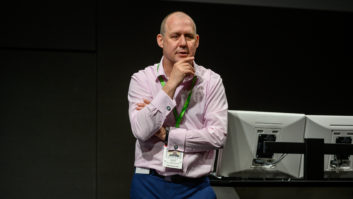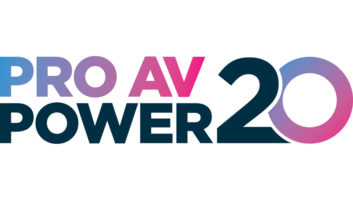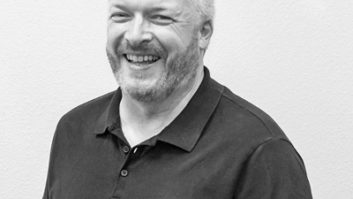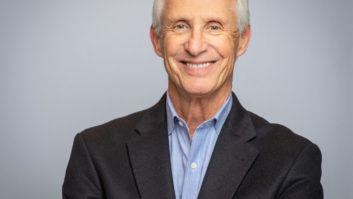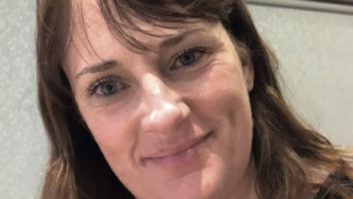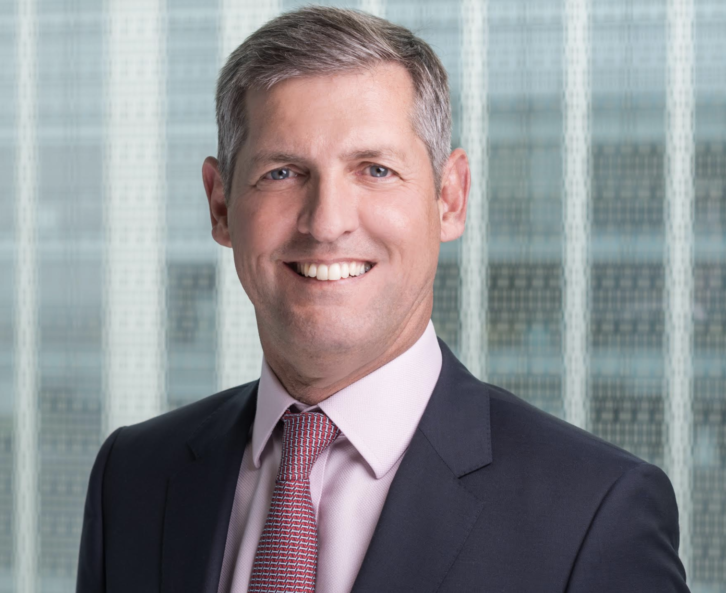
Last month, Installation revealed its first ever Pro AV Power 20 list, rounding up the most inspiring and influential figures from across the AV and installation market. To get to know them a little better, we sat down with each of our Pro AV Power 20 inductees for an in-depth chat. Here, we meet senior vice president, EMEA, Poly, Paul Clark…
How did you first get involved in the AV marketplace?
I first entered the audio industry in 1994 when I joined Plantronics, which is now known as Poly. My role then was to grow the business in EMEA, focused predominantly on personal communication devices (headsets). Back then, video conferencing was an embryonic market and AV was focused on kitting out boardrooms with audio solutions such as conference phones. My involvement with the visual side of AV became much greater when Plantronics acquired Polycom in 2018 and the two brands combined the state-of-the-art video and collaboration solutions with the industry-leading audio expertise.
What would you say are the most significant changes/developments to have taken place in the industry during your time?
The most significant change I’ve seen in the AV industry is the democratisation of video. I first used video conferencing back in 1995 and the solutions were pretty intimidating and cumbersome, as well as being very expensive. The experience wasn’t user-friendly either and we relied on IT to set up nearly every call.
Fast-forward to today and video conferencing solutions are more affordable, rich in features and, most importantly, much easier for people to use. Being able to walk into an office-based meeting room that provides one-click access to intuitive video meetings or pressing a button on a Microsoft Teams-enabled headset to join a video call from your desk has made a huge impact on the way we work.
What personal and professional achievements are you most proud of?
In 1996, I introduced the AV industry’s first headset reseller programme and created a network of resellers. There may be an ‘I’ in the idea but there is no ‘I’ in the team; the whole company invested significantly in this project. The reseller partners became the trusted experts and advisors to our customers and started helping businesses solve their technology challenges. The initiative was a significant development for the AV sector and enabled the industry to develop at a much faster rate.
In the 2000s, I moved the reseller programme online. Today, Poly resellers can find everything they need in one unified portal that provides access to all assets, training, tools and content.
Do you have a philosophy that you live by professionally? If so, what is it and how has it helped you in your career, businesses you’ve worked with, and the wider industry?
A philosophy that has greatly helped me throughout my career is that the customer comes first. I’ve been most successful when we’ve delivered what the customer wants. For example, when we took Plantronics into retail, the focus was not the retailer, but the ultimate customer who will buy the product and benefit from its usage. We built a route to market that focused on the customer’s buying and decision-making behaviours. This was pivotal to making our launch in retail stores a success. Within the space of 12 months, Poly headsets were available in more retail outlets than you could buy McDonald’s burgers!
Prior to the outbreak of the global pandemic, what would you say were the biggest areas of technological or operational challenge for the AV industry?
Prior to the outbreak of COVID-19, one of the biggest challenges for the AV industry was responding to the democratisation of AV. Traditionally, the pro AV industry was very much centred around equipping larger rooms, but today we’re experiencing the fast growth of smaller, video-enabled huddle rooms.
This is a trend that will continue through and beyond the global pandemic. While there’s still a job for AV integrators in deploying technologies in large meeting rooms with complex systems, we’ll see much greater volumes of AV equipment deployed across multiple smaller office spaces, alongside a rise in personal communications devices such as headsets and webcams.
What impact has the pandemic had on your business, and what do you think will be the longer-term impact of this extraordinary period on our sector?
I firmly believe that with the right technology people can work from anywhere. Work isn’t where you go; it’s what you do, and the pandemic has reinforced this view.
In the short term, as most offices remain closed and many people work from home, the biggest impact of the pandemic has been the rapid increase in demand for personal communications enablement. At Poly we’re seeing a huge requirement for headsets and webcams to help people work more effectively from home. In fact, the market grew so fast that the entire industry sold out of these solutions very quickly.
In the long term, as social distancing relaxes, some workers will likely go back to the office. However, we expect to see much more of a hybrid working approach, whereby work will largely be carried out at home and the office will be used more selectively.
As we see more people being in the same office at the same time, huddle rooms will be key, enabling collaboration in small groups in the same room but while the size of the group will stay smaller, the size of the meeting space will be larger to apply social distancing. In addition to this, these huddle spaces will allow flexibility to bring anyone into the meeting remotely for a rich collaboration experience. Leading cloud video services are built right into devices for seamless access, so no PC or Mac is required, and wireless content sharing lets users collaborate from their devices with no need for any cables. Artificial intelligence (AI) and machine learning (ML) offers crisp audio and automated speaker tracking to the benefit of colleagues working internationally or from home so they can easily follow the conversation.
Purchasing will shift to high quality solutions that are more feature-rich, designed human-first and take into consideration the entire context of the working space the solution is being used in.
What needs to change in the industry? What do we as a community need to get better at?
Rather than focusing efforts into deploying larger, more complex meeting spaces, the AV industry needs to start looking at how AV can be enabling the whole organisation and the different types of workspaces that employees will use.
As hybrid working becomes the ‘new normal’ the range of solutions to power human-first communication will continue to broaden. The AV industry has a responsibility to keep up with the technological developments and ideal use cases of each technology, react to new demands, provide feedback to solutions providers and guide customers in their choices.
In your opinion, what will be the biggest driver(s) of change for the AV market in the next five years?
Covid-19 will bring about two phases of work. The first phase is without a vaccine, where fewer people will commute to offices and they will be particularly conscious of safety and hygiene. The second phase, likely to be initiated when we have a vaccine, will see offices opening and operating more ‘normally’, but many employees will want to continue working from home. Both phases require personal communication and meeting room solutions that can adapt to end user needs and lifestyles.
When lockdown began, many home workers used personal headphones and built-in cameras in laptops out of necessity or purchased cheap options. But continuous working from home requires more enterprise- grade technology, with audio and video that is high quality for a professional, seamless experience. The onus will move to the employer to provide workers with the audio and video solutions to work effectively from anywhere, and it’s in the business’s interest to do so in order to manage the devices, ensure security and support users most effectively.
The rise of AV systems with facial and voice recognition built-in can also be expected. When someone joins a meeting or walks into a room, they will be recognised by the solutions which will simply ask the participant if they want to start their meeting – with the utmost privacy and security built in too.
Finally, what would be your message to those starting out their careers in the AV community?
It’s a great time to be part of the ever-changing AV community. My advice for anyone starting out their career in this industry is to be willing to learn, keep up to date with what’s happening in the market and keep close to your customers. But most importantly, enjoy the challenges that the industry throws at you because these challenges are the best opportunity for you to learn and grow.
PROFILE
Paul Clark is senior vice president, Europe, Middle East and Africa at Poly. In this role, Paul manages the company’s sales business, which spans voice, video, content, and cloud solutions, and leads the company in meeting the market need for easier, more consistent communication and collaboration experiences.
Clark has worked for Plantronics (now Poly) for nearly 25 years, holding the position of EMEA marketing director for the first ten years, and then overseeing European product management before moving into various senior sales leadership roles. In early 2016, Clark was promoted to managing director of Plantronics Europe and Africa.
During his career at Poly, Clark launched the first reseller programme, took the company into the retail market, and was an early champion of the development of the wireless headset; a significant contributor to Plantronics’ business growth.
Prior to joining Poly in 1994, Clark worked as product manager for Hitachi, where he was responsible for semiconductors for optical transmission systems. He has a degree in electrical and electronic engineering and has studied at Harvard Business School and Stanford University.
QUICKFIRE ROUND
Who’s had the greatest influence on your career?
The person who has had the greatest influence on my career is a former engineering/science teacher, Bill Watts. Sadly, he has passed away, but Bill helped me to kindle an interest and curiosity in technology. He saw in me somebody that was technologically curious, and he drove me to succeed.
Who did/do you look up to as a role model professionally?
Without a doubt it has to be Kenneth Kannappan, former CEO at Plantronics. I’ve never met anyone who is so intelligent, so focused and so clear and articulate in where he’s going – and yet so humane and supportive. Every day I try to hold myself up against Ken’s behaviour by asking myself “What would Ken have done?”
How do you measure success?
I measure success by how happy our customers are.
If you were a teenager today, what profession would you go into?
I would love to be an astronaut.
